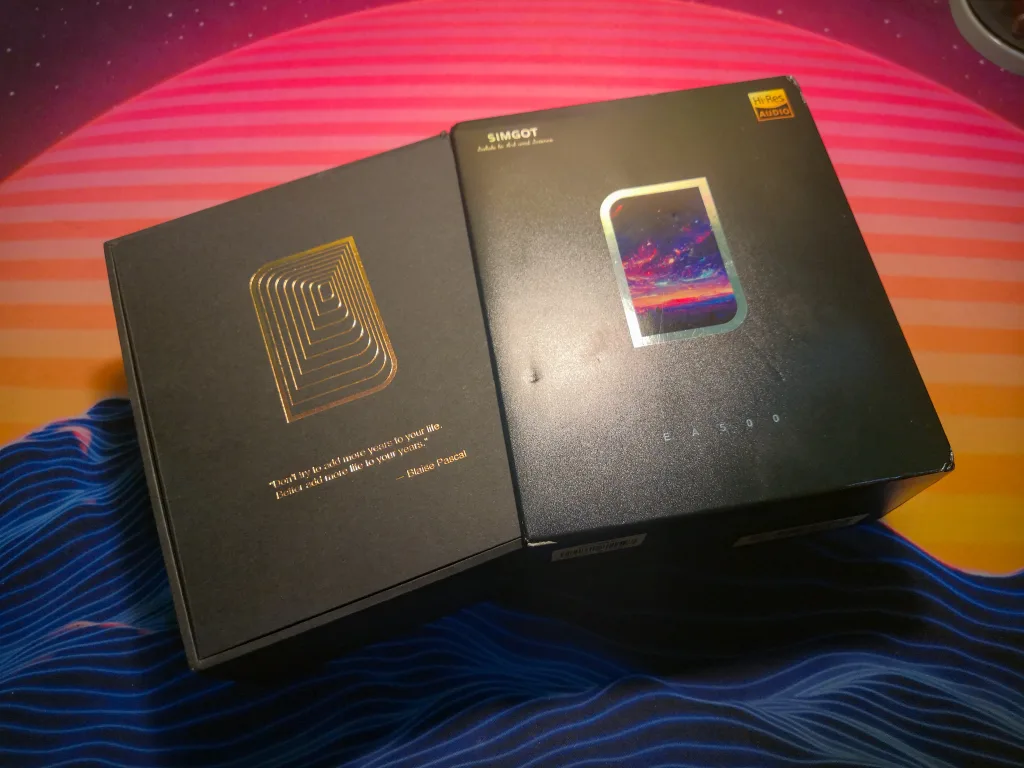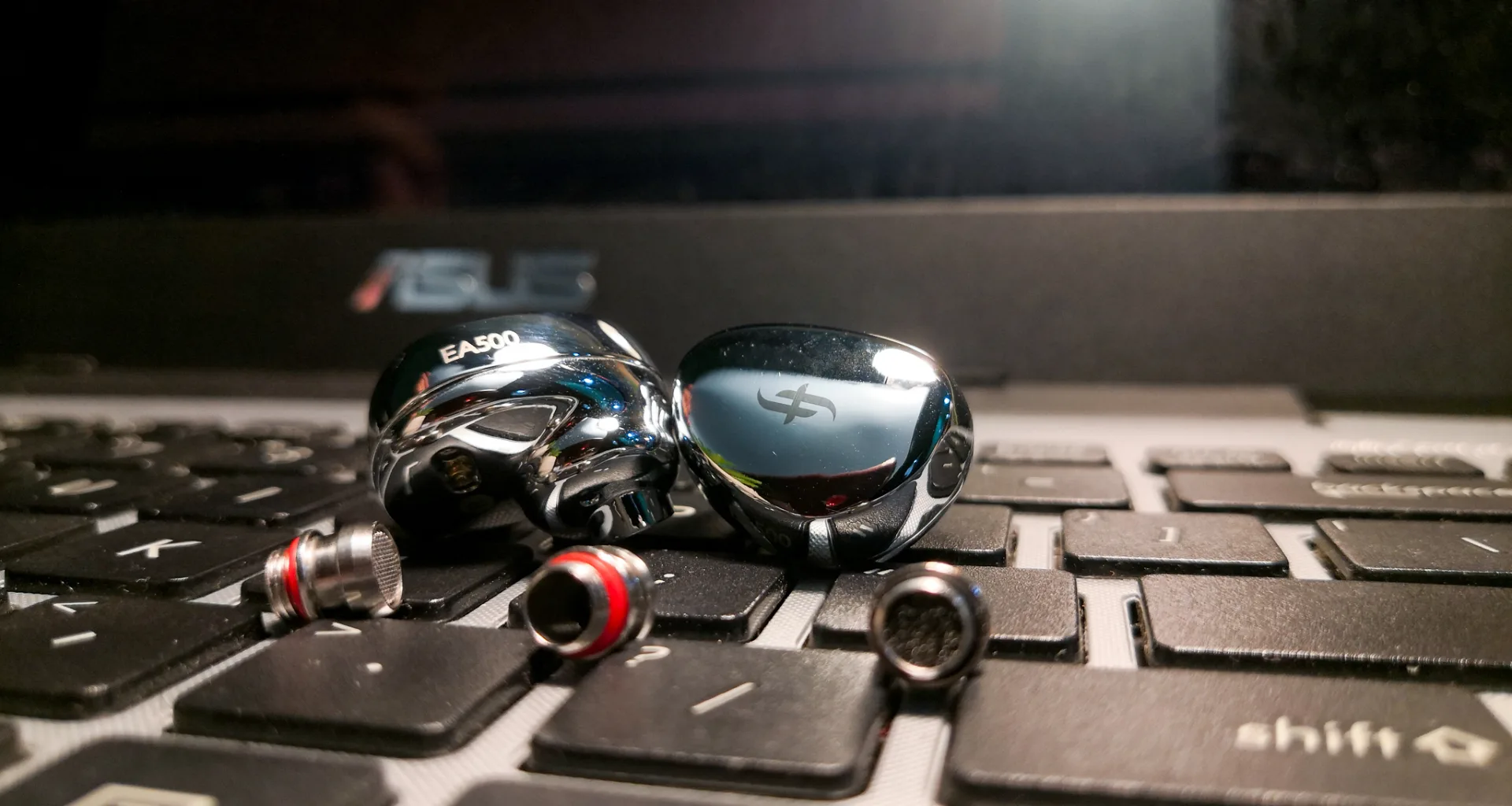Pros:
- Robust aluminium alloy build, mirror-like polish aesthetics
- Tuning flexibility with the detachable nozzles feature
- Adequate amount of accessories
- Excellent separation for under $100, shares similar DNA with the pricier EN1000
- Capable delivering tons of macrodetails
- Engaging bass, with good extension and low-bass depth
- Lush, warm tonal balance in the midrange with good timbre accuracy
- Only requires a measly amount of driving power
Cons:
- Finish is prone to debris, dust and scratches
- Loose mid-upper bass response, slight bleeding as well
- Hazy midrange, regardless on which nozzles were equipped
- Upper midrange is a tad shouty and can be intense, though results may be vary
- 5k-8kHz emphasis which causes sibilance and harshness
- Average staging and detail retrieval despite the top-end advantage
- Average isolation even with a proper, secure seal
Disclaimer
- The reviewed IEM is a purchased personal unit. Thus, all the opinions are original ideas, there is zero influence from any 3rd party or external opinions.
- No EQ or filter presets were used during the entire review period.
- Sound evaluation are kept neutral and does not include 3rd party accessories (ie; eartips, cable, reversible mods)
Introduction
The in-ear monitor category has been absolutely blessed in recent years upon plenty releases of IEMs especially within the Chi-Fi market. Within every month, each brand would unveil their latest item in their catalogue to be relished and praised by audiophiles and consumers alike especially within the $100 price bracket. An IEM that I will be reviewing this time is no stranger having caused a storm of hype with endless praises and positive feedbacks which had me travelled back into the memory lane to the hype of the Moondrop Aria and BLON BL03.
Hence, without any further explanation with me this time is the Simgot EA500, priced at only $79. This IEM features a 10mm single-dynamic driver equipped with a Diamond-like Carbon (DLC) diaphragm. Not to forget as well, the center of attraction of this IEM is none other than the detachable tuning nozzle technology. It was known much well in this hobby that this tiny technology was also featured in the Moondrop Kato, Shozy x Neo CP, Letshuoer D13 and etc. Much to my amusement seeing this kind of feature is finally brought into a much budget-friendly market and affordable for the masses.
For those who live internationally and would love to make a purchase could refer to this link through Linsoul’s platform (non-affiliated):
https://www.linsoul.com/products/simgot-ea500
For those who live in Malaysia and would love to make a purchase could refer to Red Ape Headphone Store on shopee platform (non-affiliated):
https://shopee.com.my/SIMGOT-EA500-…87&xptdk=e1c591dc-7cc4-4eea-b9d4-9e8cd56d5d87

Unboxing Experience
Unboxing the EA500 overall, was quite a pleasant, simple experience. It came in a rather small, compact packaging printed with a galaxy-themed illustration with plenty of informative specifications of the IEM, including two frequency response diagram on the back. The outer sleeve cardboard box slides out from the left unveiling an inner box which the IEM and accessories are stored.

Uniquely to Simgot, a quote by Blaise Pascal were printed onto the inner box, which I personally found really refreshing and unorthodoxly different approach compared to most of its competitors. Upon turning the flap on the inner box, you will be directly greeted by the IEM itself which are snugly fit on a cut-out foam alongside an accessories box and an eartips box where you are provided with a set of eartips of different sizes. Simgot was also kind enough to provide a decent sized IEM case, which are fairly sturdy against pressure and shock.
Not to forget also, the tuning nozzles a key feature of this IEM also included in the box, both nozzles are colour coded with red and black silicones gaskets to ensure airtight seal between the bore and nozzle. Apart from that, what made the two nozzles different from each other is that the black nozzles were filled with tuning foam on each side while the red nozzles came with tuning filters attached behind the metal mesh.
Specifications
- Driver: 10mm N52 NdFeB Dual-magnet/cavity structure with 4th Gen Diamond-like Carbon (DLC) diaphragm
- Impedance: 16 Ohm
- Sensitivity: 123dB/Vrms (@1kHz red nozzle), 124dB/Vrms (@1kHz black nozzle)
- Frequency Response: 20Hz-20kHz
- Cable: 1.2m, 4 cores high-purity silver plated OFC cable with 0.78mm 2-pin connectors
Build and Comfort
Moving onto the build of the EA500, safely said it is absolutely class from Simgot to feature an aluminium alloy chassis for the EA500 even at this low price, following the footsteps with their other higher-end models. No corners were cut in terms of the built of this IEM, although its gleaming mirror polished look would result the IEM being prone to be magnets for fingerprints, dusts or debris and an unnecessary hassle for the perfect photoshoot. Its durability against scratches were also questionable but I personally would not dare to ruin such a gorgeous pair of IEM. Regardless, there is little to no complaints regarding the build of the EA500, the detachable nozzle seems to be well-made and really well-secured with the included silicone rubber gaskets to ensure it is airtight at both ends of the bore and nozzle.
Although I had a fairly modest experience in regards of the whole Simgot line-up, having only tested its higher model which was the EN1000. Despite, this is not a direct comparison to the EN1000 but the humble EA500 has an ergonomically much comfier fit and design compared to the EN1000, I did still have to take them off though occasionally after a while due to its size and slightly heavier nature which causes my ears to sore especially around the cochlea region. Isolation were also wasn’t a key prowess of the EA500, it filters out noise fairly decent. Based on my personal experience I could hear much of the things going on within my surroundings, this of course depends on how secure one could fit the large chassis of this IEM
The included 4 core silver-plated OFC cable were also made out of fairly decent quality cable, which is not a surprise considering its price point. It has a very minimal amount of microphonic especially when wearing the IEM while on-the-go, the thick PVC coating on the outer layer provides a rubbery, fairly supple feeling and tangle-free although still I would consider this cable would be in the slightly firmer side.
Test Equipment
- Apple Music/Spotify + Local files via HiBy Music > Letshuoer DT02 dongle DAC/AMP (1 Vrms@32 Ohms (SE) and 2 Vrms@300 Ohms (Bal).
- Apple Music/Spotify (100%) + Local files via HiBy Music (32/32) > SMSL Sanskrit MKII > Aune X7s
- Laptop
- Smartphone
Power Requirements
Driving the EA500 requires a measly amount of power out of your dongles and portable amplifiers. Hence, a desktop level amplification is definitely unnecessary, a phone would run this IEM adequately. Since, this IEM is rated at only 123dB/Vrms with the red nozzle equipped and a dB higher when equipped with the black nozzle. That being said, the higher sensitivity does not seem to make the EA500 prone to emit any sort of background noises nor hisses when plugged across various sources.
Based on personal experience, plugging the EA500 into the Letshuoer DT02 dongle which is rated at 1 Vrms@32 Ohms (SE) and utilizing the in-app volume of the HibyMusic as a reference. The EA500 only required me to increase the volume up to 2-4/32 for my comfortable casual and critical listening.
Initial Impression
Upon listening it for the first time, the first thing that came to mind was the separation that the EA500 could produce for a single-dynamic. It sounded identically similar to its higher-end model which I praised in my previous reviews of the Simgot EN1000. To pull it off in a similar manner but inside a much lower-end segment of the market is honestly quite impressive by any means, perhaps this is something that specifically Simgot are really good at.
Apart from that, the overall sound signature that this IEM possesses a Harman Target set of tuning that pretty much everyone is familiar with, having this sort of tuning will always leads to a recessed midrange especially for vocals. Higher frequencies were quite sizzly or almost tizzy at times which is not necessarily a negative point but what matters more is that there is an accentuated amount of sibilance which might be an early red flag for some demograph.
Despite that being said, the detachable tuning nozzles that the EA500 came with allowing flexibility for users to switch between a milder, leaner bass-shelf with greater treble extension with the black nozzle or a much warmer, prominent Harman signature and balanced sound across the frequency spectrum with the included red nozzle. The rest of the sound evaluation below will be carried using the black nozzles since that is the stock tuning and accustomed by Simgot for the EA500.
Low Frequency (Bass)
Dwelling straight into the lowest part of the spectrum, the 10mm DLC dynamic driver presents low-end quite lean, impactful and fast. Starting from the sub-bass, rumbles were light yet still capable of rendering modest amount of texture and detail. For example, in the track Hollow (16-Bit Remix) – Björk the EA500 passes this track quite well capable of rendering deep sub-bass rumble in the first 30 seconds into the track. The waving rumbles were nicely textured with decent clarity as per macrodetails goes, that does unfortunately turned a tad dull upon using the red nozzles. Although, it was not something that is mind blowing, its still commendable for the under $100 market.
The mid to upper bass region of the EA500 were engaging, well-extended and enjoyable with its impactful and fast bass response. Each bass slam resembles a chesty punch, with decent note weight and finished with a slow, extended decay. Which then, complemented by the fast, hard response giving it a pleasureable experience despite being nowhere near what it would call a tight visceral bass. Tracks such as Hunter – Björk testing the capability of the EA500 to its utmost. The IEM presented the track as per expected, each bass transients were fast and the EA500 could catch up quite nicely, although the resonance between each bass impact were quite loose and the slow decay which eventually cause some melding between each transient.
Middle Frequency (Mid)
As we continue, as far as mid frequency goes the EA500 has a fairly flat and a tad recessed midrange with a slightly warm tonal balance within 100Hz-500Hz by a couple decibels. This gives it a noticeable lushness and thickness especially genres that has a lot of vocal and acoustical elements. For instance, in the track A Poem Titled You – Taeyeon, the slight additional emphasis allowed the piano and Taeyeon’s voice to be slightly warmer and thicker than neutral, reverberations were also quite emphasized hence each key from the piano has a lingering sounds of reverb.
Although, the emphasis does brought some positives in some respect which I personally think the EA500 does benefit from it. This also came with a cost, whereby the added upper-bass to midrange causes the mids sounded slightly hazy and muddy. Both nozzles does not seem to be able to reduce this effect as the red nozzle only seemed to make it a tad less muddy and controlled yet the haziness still persist. Moreover, the upper midrange region could get a tad shouty and intense occasionally, even though it was not severe but it is certainly something that users would notice.
High Frequency (Treble)
Treble was also an area that is the main spotlight of the EA500, suitedly perfect with its design and mirror-like shine aesthetics. This IEM has an emphasized treble region and seemed to be quite spiky as well at certain regions especially within the upper-highs, which could be smoothen out to some extend by equipping the red nozzles that meant to provide a much warmer, laid-back tuning.
That said, the EA500 possesses a treble that is modestly bright, crisp, quite airy and sparkly as well. Timbre of cymbals (i.e., china/ride/crash cymbals) sounded quite realistic and distinguishable with an added crisp at each tail, while hi-hats in the other hand could occasionally sounded a tad too tizzy at times. Other than its brightness to note here, there were also sibilance to be found probably due to a spike around 5k-8kHz, which causes most elements that reaches up to that frequency to sound sharp and coarse. This of course, easily been heard through vocals such as in the track Ignorance (Acoustical) – Paramore, where the EA500 seems too accentuate the sibilance from Hayley William’s voice. Even with the warmer, laid-back sounding red nozzles equipped, the sibilance does still persists although it is toned down slightly flatter to a much tolerable degree. Plus, airiness were also affected when equipping the red nozzle hence, it might sounded slightly closed, with darker sound due to the slight treble roll-off.
Technicality
Moving onto the technicalities for the EA500, the soundstaging of this IEM was quite average and intimate, although it would be nowhere to be called “holographic”. There was not a lot of width within the staging but depth wise from front to back was decent and roomy, as well as for its staging height. Its spatial imaging is another story. Imaging wise, the EA500 could pinpoint elements quite sharp, solid for something that is under the $100 market. For instance, in Bubbles – Yosi Horikawa whereby in one part into the track, there is a rolling effect on one of the ball on the far left moving forward which the EA500 could follow the movement of the ball accurately.
Next, apart from the pinpointly accurate imaging, the detail retrieval that this IEM possseses were also one of the key strength. Despite it would not render subtle nuances and microdetails delicately, this IEM is still capable to dish out tons of macrodetails and high-level textures out of your music, which does unsurprisingly dulls out when equipping the red nozzle. Separation and layering was also seems to be well-executed in separating vocals from other elements similar to its bigger brother the EN1000. But avoid all of such praises fool you, occasionally while the vocals between passages were separated, other instruments/precussions poorly tend to meld and layered onto each other.
Last but not least, the dynamic range for the EA500 was average at best. Utilizing the Ultimate Headphone Test – ABYSS Headphone dynamic range test as a reference. In which explained in short, a sample sound of a drum and a bell are played simultaneously as much as 7 counts, but only the sound of the bells will become quieter. Hence, from a scale of 7 counts, the EA500 was able to produce an audible 5 out of 7 counts.
Conclusion
For my final verdict, the Simgot EA500 is a solid option into your consideration list for IEMs under the $100 mark. Despite the slight shortcomings, this IEM is definitely worth a consider for audiophiles that care about midrange quality that shares the similar DNA in its bigger higher-end EN1000, with good separation and the unique naturalness that audiophiles crave from a single-dynamic driver. Simgot has yet again produced a high-quality product and being consistent driving towards excellence in terms of the product that they have released in recent times, which I hope this positive trend will continue.
Achieving a snug seal and proper fit is the utmost importance to get out of the most from this IEM which is also my main complaint on its bigger sibling which was the EN1000. A slight leak on the seal will affect the sound quality you are getting from the EA500. Of course with a little investment on better eartips such as Azla Xelastec would provide excellent seal required whlist further enhance the midrange and allowing tighter, cleaner bass response this competent performer in the $100 market.
Additional Test Tracks
Anesthetize – Porcupine Tree DSD256
First Love – Hikaru Utada 44.1kHz
Masquerade – Lindsey Stirling 44.1kHz
Motherboard – Daft Punk DSD256
添迷不悔 (Zhi Mi Bu Hui) – Faye Wong DSD256
Keroncong Hybrid For Bidadari – Pot Amir 44.1kHz
Would? – Alice in Chains 44.1kHz
Veronica – Red Hot Chilli Pepper 192kHz
Furiko – Uru 44.1kHz









